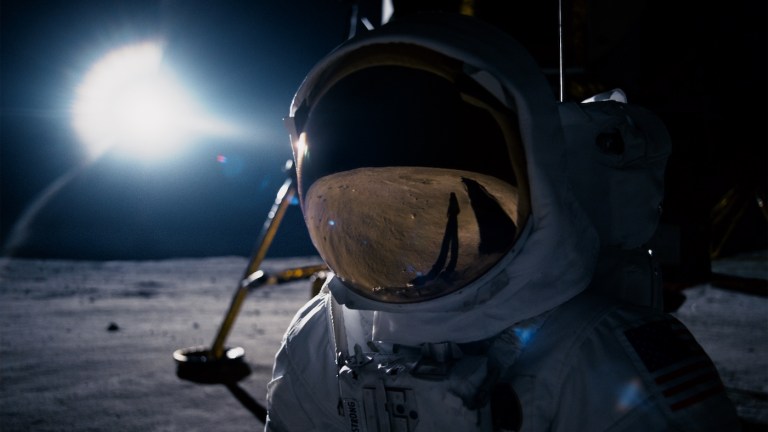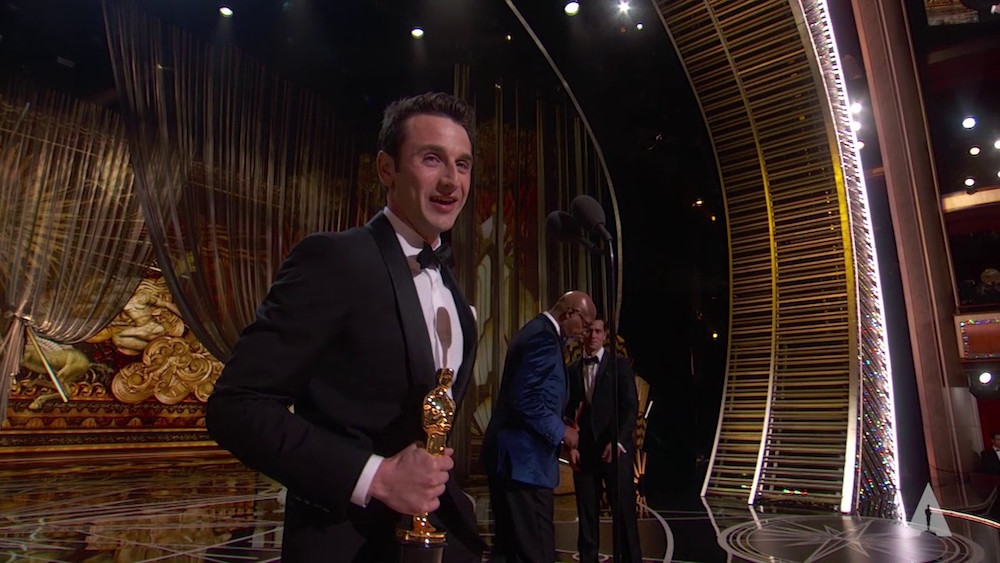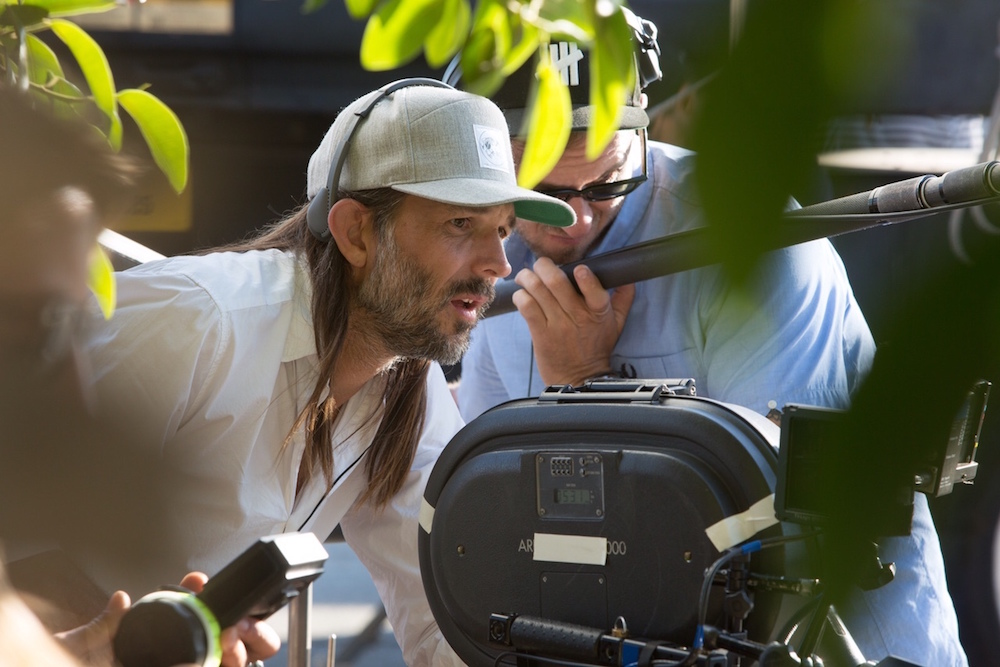First Man: Making the Moon Sing with Justin Hurwitz
Oscar winning composer Justin Hurwitz and cinematographer Linus Sandgren discuss finding the soul of the man in the moon in First Man.

The soul of First Man was written, both aurally and visually, before Ryan Gosling’s Neil Armstrong ever stepped foot on the moon. That is at least one of the major takeaways from speaking with composer Justin Hurwitz and cinematographer Linus Sandgren. The day before we sat down for coffee, First Man had just premiered at the Toronto International Film Festival, where it’d been presented above the waters of Lake Ontario upon the first IMAX screen ever built for North American soil. Such a grandly cinematic debut on a landmark of engineering was clearly apt.
The final sequence of First Man, in which Gosling’s Armstrong rockets above the heavens and lands on a distant rock that may as well be in another universe, follows the tradition of ascendant, heartbreaking endings earned in director Damien Chazelle’s other films, Whiplash and La La Land. Like those movies, triumph is not achieved without much sacrifice, and the way the sequence is presented by Hurwitz’s melancholic and even haunting music—which turns the 1950s instrument of choice for B-science fiction, the theremin, into something akin to the sound of weeping antennas—as well as Sandgren’s final switch from Super 16mm photography inside the lunar capsule to stunning IMAX 65mm outside of it, is genuinely breathtaking. It is also something that Chazelle, Hurwitz, and even Sandgren began piecing together in some small form before filming on La La Land began—that stunning musical throwback that netted all three men Oscars last year.
“I remember even one of the first times I heard about this… Damien had just sat down with Ryan Gosling to actually talk about this project, not La La Land,” Hurwitz says. “[It was] before Ryan came to do La La Land, so I was hearing about this very early on, and then we got busy making La La Land.” And while Hurwitz and Chazelle threw themselves into the musical they’d been building to since rooming together as Harvard undergraduates, it was still as early as post-production on that film that Hurwitz saw screenwriter Josh Singer visiting Chazelle in the editing suite to get cracking on the Neil Armstrong movie.
“It became, for me, really a full time job in March of 2017 when these guys started to prep it,” Hurwitz recalls. Awards season was over, and with that release cycle finished, work began in earnest on First Man—surprisingly in much the same way it had on their two collaborations before it. Rather than the end of Chazelle and Hurwitz’s more musical approach to moviemaking, First Man added a new layer to a creative process that arguably begins in earnest on Hurwitz’s piano.
Says Hurwitz, “It was similar in some ways to what it’s been in the past, which is we try to figure out as much as we can before the movie is shot. Meaning the very first thing we do is just try to find the main themes and the melodies of the movie. We love very thematic scores. So the first thing I do is sit down at the piano and then just start sending tons of piano demos to Damien until we find it.” And as that process developed over the summer of 2017, Hurwitz would record demos that ultimately came to form the audible foundation of animatics for key moments in First Man, including the final moon landing.
“It was like we were drawing from the background we had making musicals, where you have to make some big pieces of score early on. I think Damien really liked knowing the sort of sound of it and the melodies, and even structurally what it was going to be, as he was prepping, as he was shooting.”
While Hurwitz stops short of saying his music directly influences how Chazelle envisions the movie, Sandgren is much more to the point in suggesting that he thinks the music the director and composer agree on helps pave the way to the visual aesthetic the rest of the picture.
“On La La Land, it was crucial for the images,” Sandgren considers, “but also here, it was really helpful. Both for Damien to explain the film to his crew and also for us to create the images.”

further reading – First Man: The Mystery of Neil Armstrong
When it came to crafting those moonscapes, Sandgren felt, like Hurwitz, a need to break away from how most space films have been photographed or scored, even as the picture reaches back to the in-camera techniques pioneered by Stanley Kubrick’s 2001: A Space Odyssey (and recently revived in Christopher Nolan’s Interstellar).
“On one hand, he spoke to me about doing this as a documentary, like a type of documentary from that time, as if we were documentary filmmakers actually being with Neil Armstrong and his family behind the scenes in his kitchen,” Sandgren says. “But then we follow him in a very realistic way to space, which is sort of a quite unusual approach to space movies, where you want to feel more like you’re actually really there with them as a documentary filmmaker. As with the score for space, which is so poetic, actually, and beautiful, it’s actually something that inspired us to make the imagery also more poetic, out there.”
In terms of visualizing the space travel in the film, this required filming many of the sequences before the final Apollo 11 space mission solely from the vantage of Neil Armstrong’s various cockpits and capsules, be it the X-15 fighter jet or Gemini 8 space mission.
Says Sandgren, “That comes sort of with the whole approach of being realistic and as if we were experiencing this with the characters… So you can be inside a capsule and you can’t really be outside of it unless you have craft-mounted cameras, which existed. We were actually particular about finding those positions that were realistic. There’s actually shots of, for example, the X-15 over the tail. Just like we did it, in a similar shot, they shot with small cameras that were attached somehow in the body of the crafts.”
In this vein, Sandgren and Chazelle also approached the film with a look that visually evolved throughout the picture. While First Man eventually follows Interstellar into breathtaking, analogue IMAX photography on real sets, the actual inside of the capsules are shot in Super 16mm throughout the picture, as are early painful scenes of Armstrong with his ailing daughter. In-between, as Armstrong ever gets closer to that big rock in the sky, 35mm photography is introduced, allowing for this world’s grandeur to build until all the grain disappears atop the moon.
“Early on, we discussed shooting the entire film on Super 16 because we felt that would be both the most truthful for the time, being sort of a documentary, but also it felt like that would be the most human format to get close and intimate with people,” Sandgren explains. “So when we were very intimate with his daughter and in those moments in the beginning of the film, it’s all Super 16. Inside the crafts are Super 16, because it’s grittier and a little more textured, obviously, with the grain… Then at home in Houston, we went with softer 35mm, but with the same style of photography.”
And then comes that ending in IMAX. The actual lunar landing scene—complete with flag in the ground—was filmed in a full-scale rock quarry that was supposed to be 500 by 500 feet, although Sandgren suggests it was closer to an acre. While much of the film uses enormous miniatures for the space shuttles—including a 14-foot Saturn V rocket—as well as sophisticated rear-projection as opposed to blue screen, everything is to exact scale on the moon, including the lunar capsule.
“So then you go from Super 16 inside a craft, and as they open the door you go to IMAX,” Sandgren marvels. “I think both visually and with sound, and with sort of everything, we’re going suddenly out into this super weird surreal world. Even though it’s not a documentary anymore, and now it’s another style. Now it’s just all floating.”

further reading: First Man’s Ending Explains Damien Chazelle’s Masterful Vision
And this is achieved with the music that Hurwitz has developed in the pre-production process and finessed during the post-production process. Indeed, Hurwitz notes that while he wrote themes beforehand, seeing the handheld, grainy aesthetic achieved by Chazelle and Sandgren then informed how he actually scored the picture.
Says Hurwitz, “[Damien] told me from the very beginning, this has to sound completely different than anything we’ve done. It’s not jazz, obviously, it can’t sound like a traditional orchestra, there will probably be orchestra in it and there is orchestra in it, but like we would have to do things to make it sound different, make it sound weirder, more other-worldly.”
This difference was also very much informed by how Chazelle and screenwriter Josh Singer envisioned Armstrong’s journey being one of pain. Only during the docking sequence of Gemini 8, a moment of rare serenity and completeness for Armstrong occurring in his first mission out of the atmosphere, does the score approach what Hurwitz calls their “Tchaikovsky or Offenbach” orchestration.
“There is a cue that we called the ‘Docking Waltz,’ which is kind of our wink at the 2001 treatment of space where we were, very obviously, being influenced by the same sort of classical music that is used in space films.” Even so, the final piece is still a riff on the usually much more somber theme Hurwitz wrote for the beginning of the film, “Karen’s Theme,” which plays in the transition from Armstrong watching his daughter fading away to burying her at a funeral.
“There’s a lot more pain and grief in this story, and their approach to this story, than I think we’re used to seeing in space stories,” Hurwitz says. “So in sequences where normally the score might be all about the triumph of it, here it’s triumph mixed with pain. I’m thinking of the Apollo 11 launch or the actual landing cue as we’re getting closer. It’s like, this whole mission is very exciting. Damien always wanted these parts of the movie to be very exciting, but everything in the years of Neil Armstrong’s life leading up to it is sort of giving it an undercurrent of pain and loneliness, and grief. So the music has to also have those colors in it as well.”
The result is a genuinely intimate film that marries the agony and ecstasy of achievement perhaps more viscerally than Chazelle’s other two films. The difference is seen in the contrast of the 16mm close-ups of Armstrong and his wife Janet (Claire Foy) in the kitchen as a solitary harp plays, and the lonely vastness of a lunar landscape in the highest cinematic resolution possible, all underscored by that oh, so persistent theremin.
“The theremin and the synth, and some of the kind of fluttery, effected strings,” Hurwitz muses, “just give it hints of some of that other-worldly quality that is sort of either in the back of Neil’s mind or part of the story in other ways.” That is until it encompasses the whole film’s end, and a familiar bittersweet refrain echoes across the footprints in the moon dust. It’s an echo that lasts well after those credits begin to roll.
First Man opens in theaters nationwide on Friday, Oct. 12.
Read and download the Den of Geek NYCC 2018 Special Edition Magazine right here!
David Crow is the Film Section Editor at Den of Geek. He’s also a member of the Online Film Critics Society. Read more of his work here. You can follow him on Twitter @DCrowsNest.